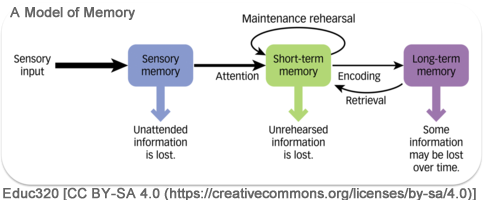This post is by Peter Arthur.
Chapter 8 BIG Idea
Similar to intelligence, mindsets are malleable and can be developed. There are many curricular interventions teachers may implement to support students with developing a strong growth mindset towards intelligence and all areas of life.
What is Growth and Fixed Mindset?
Students with a fixed mindset believe their basic abilities, their intelligence, their talents, are just fixed traits. They have a certain amount and that’s that. Many of us have heard a student stating that they are bad at _____, has always been bad at ______, their brother is bad at _____, their sister is bad at _____ and they are bad at _____…they were born that way and there is nothing they can do about it. Conversely, students with a growth mindset understand that their talents and abilities can be developed through effort, good teaching and persistence. They don’t necessarily think everyone’s the same or anyone can be Einstein, but they believe everyone can get smarter if they work at it.
Mindset has an impact on a student’s motivation to work in the face of failure and setbacks. Those students who attribute failure to their own inability i.e. “I’m not Intelligent” become helpless because it is something they can’t control. However, those who interpret failure as a result of insufficient effort or an ineffective strategy dig deeper and try different approaches. This is something a student CAN control
Mindset Strategies to Integrate into your Teaching
1. Reward Growth – Design your assessment strategy to align with rewarding intellectual growth.
- Weigh later assignments I the same sequence for heavily than earlier ones. i.e 10, 15, 20, 25. This provides students the opportunity to have a setback early, and learn from it.
- Allow students to revise work or retake exams. For example, provide students the opportunity to revise or retake it.
2. Give Growth-Language Feedback
- Praise effort rather than talent. Instead of telling a student, “You are a talented mathematician,” say, “You must have worked really hard on your mathematics and it shows!”
3. Growth Talk – Be mindful of the way you communicate with students to reinforce a growth verses fixed mindset.
- When you communicate with students be careful not to reinforce a fixed mindset i.e. you either know how to write or you don’t. Instead communicate growth talk by reinforcing effort rather than natural talent i.e. share a story of how a student worked hard in your course and learned a lot.
- Note: it is recommended to check your syllabus and assignments for fixed vs growth talk.
4. Promote Success Strategies
- Provide specific advice on how to learn and succeed in your course.
- Communication example, “I think that if you will put in a good effort next semester, you will be absolutely amazed by how much you can learn about financial accounting.”
Strategies I Have Implemented
- Directly taught that intelligence is malleable and can be developed with effort.
- Reinforced the importance of embracing challenge. Only through challenge will there be growth. Some students feel they must be “not smart” if they are having difficulty learning a competency, however, they often do not realize the challenge is very important and key to learning growth. An example of this is Bjork’s “desirable difficulties” to enhance learning.
- Failure Mindsets. Support students with viewing setbacks and failure as something that happens to us all and we can view it as either debilitating or as an experience that facilitates learning and growth.
Principles
- Design for Growth
- How can you reward students for their effort and provide opportunities to revise and improve their work? i.e. make one assignment per semester open for revision.
- Communicate for Growth
- Communicate with students using a growth mindset language (see strategies above).
- Feedback for Growth
- Provide formative feedback with growth mindset language i.e. “All of this will require effort on your part, but that effort should really pay off on your next ”
Small Teaching Quick Tips
- Provide early success opportunities through assignment sequencing or assessment design.
- Provide examples of initial failures or setbacks in your own intellectual journey or in those of famous or recognizable figures in your field to demonstrate that such failures can be overcome. The example I use is Steve Jobs. Steve Jobs was actually fired from Apple Computers. When Jobs was fired from Apple, he was quoted to say “I didn’t see it then, but it turned out that getting fired from Apple was the best thing that could have ever happened to me.”
- Give feedback to students in growth language; convey the message that they are capable of improvement, and offer specific instructions on how to achieve the improvement.
- Include a “Tips for Success in This Course” section on your syllabus, and refer to it throughout the semester.
Questions to Connect to Your Life
- In what areas of your life do you have a growth and/or a fixed mindset?
- What strategies do you use to mitigate a fixed mindset in your own life?
- In what ways have you witnessed either a growth or fixed mindset among students in your educational context?
- Reflecting on your teaching practice, in what ways are you developing a student’s growth mindset?
Notable Recent Papers on Mindset
In my opinion the following two papers are the most significant recent papers on mindset. The first is a meta-analysis that found the effect size of mindset to be weak, however, studies reinforced that low socioeconomic status and academically at-risk students might benefit from mindset interventions. The Second article published in Nature, indicated that a short online growth mindset intervention improved grades among lower-achieving students and increased overall enrolment to advanced mathematics courses.
Sisk, V. F., Burgoyne, A. P., Sun, J., Butler, J. L., & Macnamara, B. N. (2018). To what extent and under which circumstances are growth mind-sets important to academic achievement? two meta-analyses. Psychological Science, 29(4), 549-571. doi:10.1177/0956797617739704
Found online: https://www.creatingrounds.com/uploads/9/6/2/4/96240662/meta-analysis_growth_mindset.pdf
Yeager, D. S., Hanselman, P., Walton, G. M., Murray, J. S., Crosnoe, R., Muller, C., . . . Dweck, C. S. (2019). A national experiment reveals where a growth mindset improves achievement. Nature, 573(7774), 364-369. doi:10.1038/s41586-019-1466-y Found online: https://www.nature.com/articles/s41586-019-1466-y
How do you use strategies such as those discussed in “Chapter 8: Growing”? Share your ideas in the online Chapter discussions in Mattermost during this week and join us for the live web conference meetup Friday, November 8th at 11:00am PST. It’s easy to create an account and join in on the discussion. See How to Participate.




